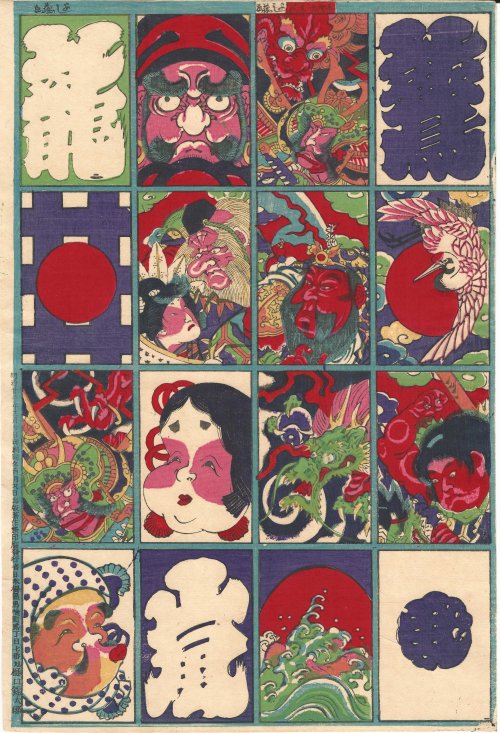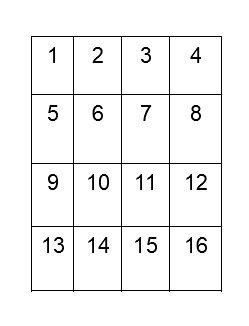| |
YOSHIFUJIUtagawa YOSHIFUJI(1828 - 1887)'Toy Print' |
|
|
 |

|
Toy Print
(Omocha-e, おもちゃえ)
1889
Series - ~
Artist - see Biography
Signature - Yoshifuji-ga ( 芳藤) on upper selvage above design No. 1 and design No. 3 (right hand to the small red title cassette)
(Omocha-e, おもちゃえ)
1889
Comment - Uncut single sheet omocha-e, with 16
classical kite designs for Edo
kites or Edo Kaku
kites. The title of the print is written on the selvage above
design No.3 in the small red casette ("omocha-e", "おもちゃ え")
written in Hiragana.
The designs are as follows:
| No. 1
|
"Kanji kite" ("ji tako", "字凧") with Kanji character for "Dragon" (Ryū, 龍) | |
| No. 2 |
Daruma
face design |
|
| No. 3 | Dragon and warrior design; supposedly the story of 'Raiko attacking the demon', a widespread story , even depicted on a stamp, or as a famous surimono by Hokkei | |
| No. 4 |
"Kanji kite" ("ji tako", "字凧") | |
| No. 5 |
A variation of the Japanese flag, often
to be seen on classical kite woodblock prints, for
instance 1,
2,
3,
4 ... |
|
| No. 6 |
A grumpy old man with a black cap
addressing a blushing younger one. |
|
| No. 7 |
A scene of the historical tale "Romance
of the Three Kingdoms," a story about the three
warring kingdoms in China during the third century,
often played in Kabuki theatres. The red faced warrior
is Kan'u (関羽), a general of Eastern Han. |
|
| No. 8 |
A red sun
with a crane on it. The crane is an important
symbol for long life. The depicted scene is a typical
'hinode tsuru' (日乃出鶴 ) motif. 'Hinode' means
'sunrise', tsuru means 'crane'. The 'hinodetsuro' is
also a traditional motif connected to Asahina. |
|
| No. 9 |
A claw from a mysteriously big bird-of
prey reaching out to ta warrior |
|
| No. 10 |
Okame,
the Goddess of dawn, mirth and revelry, supposed to be
a lucky charm |
|
| No. 11 |
Dragon scene |
|
| No. 12 |
Red faced fighter, maybe a grown up Kintaro | |
| No. 13 |
A design depicting 'Hyotoko' (火男 or ひょっとこ) with his puckered and bent look. He is the male counterpart of Okame. | |
| No. 14 |
"Kanji kite" ("ji tako", "字凧"), design with the character for "Storm" (Arashi, 嵐) | |
| No. 15 | A depiction of the widespread story of the "Rabbit in the Moon". Despite the "western view" of the red ball as seen as the Sun, it is indeed the Moon, therfore the night blue background. The curly waves are to be intended as 'smoke'. The Rabbit is only hinted at behind the curly 'waves'. Because of self sacrificing, the Rabbit is sent as a reward to the Moon by Teishakuten. Teishakuten is in 'Western eyes' the higher supreme celestial being. | |
| No. 16 |
"Kanji kite" ("ji tako", "字凧") |
Please compare this print with the toy print from
KUNIAKI-II, and the small edo
kite chiyogami from an unknown woodblock artist of the
Meiji-era.
Series - ~
Artist - see Biography
Signature - Yoshifuji-ga ( 芳藤) on upper selvage above design No. 1 and design No. 3 (right hand to the small red title cassette)
Publisher - Higuchi Katabe
('Higuchi Takagi', 樋口鋠太巨郞) on lower left selvage (left to
design No. 9 and 13), with date ande complete address
(明治廿二年士一月年土一月七日的刷同年冂月共日出版著作兼的刷發行者日本橋區肃哏町貳丁目七番规樋口鋠太巨郞)
Image Size - 25.3 X 37.1cm (9 1/15" x 28")
Condition - single sheet; nishiki-e (cloured woodblock); omocha-e (toy print); vertical ôban (ôban tate-e);
Image Size - 25.3 X 37.1cm (9 1/15" x 28")
Condition - single sheet; nishiki-e (cloured woodblock); omocha-e (toy print); vertical ôban (ôban tate-e);
Copyright 2008 ff: Hans P. Boehme